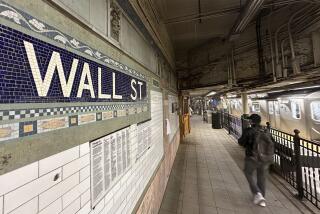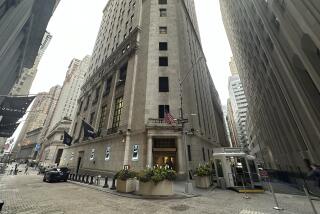Dow Spurts 15 to Push Past the 2,700 Barrier; Other Indicators Mixed
NEW YORK — The bull market in blue-chip stocks kept rolling on Monday, lifting the Dow Jones index of 30 industrials to its first close above 2,700.
However, some broader measures of market trends settled for more modest gains or even posted losses in a mixed session of slackened trading.
The Dow index climbed 15.14 to 2,700.57, one week after its first close above 2,600.
Since the beginning of the year, the index has risen 804.62, or 42.44%.
Volume on the New York Stock Exchange came to 166.12 million shares, down from 196.12 million Friday.
The Dow crossed 2,700 briefly on Thursday and Friday but dropped a bit each time in the course of rolling up a record weekly gain.
Analysts said the market was apparently faced with some planned selling at that level by traders and money managers at investing institutions. Nevertheless, they said, enthusiasm for stocks was still running high, and many investors still seemed eager to get in on the bull market.
Wall Streeters were especially impressed by the market’s resilience Friday, when it posted only a modest loss despite disappointing news on the nation’s trade deficit.
Takeover Stocks Active
“The market kept edging up and at the closing bell passed 2,700--that is a very, very bullish development,” said trader John Havens of Morgan Stanley. “We will have to see what happens overnight in foreign markets, but I think this sets the stage for another big gain tomorrow.”
Activity remained brisk in the mergers and acquisitions arena Monday.
Gillette, the day’s most active issue, rose 3 to 43 1/8. Revlon made a proposal to acquire the company for $47 a share in cash and securities.
ADT Inc. jumped 14 3/8 to 48 5/8 on word that Hawley Group of Britain began a $47-a-share takeover bid.
North American Philips climbed 11 1/8 to 53 1/8. N.V. Philips of the Netherlands, which owns 58% of the company, offered $50 a share for the rest of it.
Blue chips contributing to the Dow’s gain included Merck, up 3 3/8 at 207 3/4; Philip Morris, up 1 1/8 at 105; McDonald’s, up 1 3/8 at 60 7/8; International Business Machines, up 1 at 174 1/2, and General Electric, up 1 1/8 at 65 1/8.
Other Indexes Mixed
Elsewhere, NWA dropped 1 5/8 to 71 3/8 following the crash Sunday night in the Detroit area of a Northwest Airlines plane in which more than 150 people were killed.
Todd Shipyards fell 1 3/4 to 5 3/4. The company filed a petition under Chapter 11 of the U.S. Bankruptcy Code.
Declining issues slightly outnumbered advances in the daily tally on the NYSE, with 761 up, 817 down and 430 unchanged.
The exchange’s composite index of all its listed common stocks edged up 0.07 to 186.76. The Wilshire index of 5,000 equities closed at 3,275.130, up 1.185.
Standard & Poor’s index of 400 industrials dipped 0.01 to 389.37; S&P;’s 500-stock composite index rose 0.12 to 334.11.
The NASDAQ composite index added 0.04 to 451.65; the American Stock Exchange index closed at 362.87, down 0.74.
Nationwide turnover in NYSE-listed issues, including those stocks on regional exchanges and in the over-the-counter market, totaled 196.45 million shares.
In the bond market, prices slipped lower Monday in response to the dollar’s weakness in foreign exchange markets.
Analysts said trading was light as bond investors continued to wrestle with their uncertainties about the economy.
The Treasury’s 30-year bond fell about 1/2 point, or about $5 for every $1,000 in face value. Its yield stood at 8.79%, up from 8.77% on Friday.
“It’s now a question of how the market wants to take the trade numbers of last week . . . whether it wants to take them to heart or shrug them off,” said Robert Brusca, chief economist for Nikko Securities Co. International.
The government reported Friday that the nation’s trade deficit widened in June to $15.71 billion, a signal to some that the dollar’s value could erode further and that inflation could accelerate.
Although the government bond market managed some slight gains after the trade news was announced, the report appeared to take the steam out of a rally that had been inspired by heavy demand for the new Treasury issues auctioned last week.
Monday’s session began with a slight strengthening in the 30-year bond in response to a sharp drop in oil futures prices. But those reports were countered later in the day by news of higher prices for other basic commodities and the weakness in the dollar.
The combination left bond investors as uneasy as ever about the future course of inflation. Higher inflation is a bearish sign for bonds because it dilutes the return on fixed-rate investments.
Fed Funds Rate Higher
“If the dollar drifts lower, it eventually revives inflation psychology,” said David Jones, an economist with Aubrey G. Lanston & Co.
Jones said the increase in the operating rate of the nation’s factories, reported Monday, also contributed to the bond market’s nagging inflation worries.
The government said factories, mines and utilities operated at 80.5% of capacity in July, the fastest pace in 18 months.
The federal funds rate, the interest on overnight loans between banks, also traded higher, unnerving those who needed to borrow funds to pay for last week’s bond purchases.
The federal funds rate was quoted in late trading at 6.81%, up from 6.75% on Friday.
In the secondary market for Treasury bonds, prices of short-term governments fell 1/32 to 1/16 point and intermediate maturities fell 1/16 point to 3/16 point. Long-term issues were up 3/16 point, according to Telerate Systems Inc., a financial information service.
The movement of a point is equivalent to a change of $10 in the price of a $1,000 bond.
In corporate trading, industrials and utilities were off point in light trading.
Among tax-exempt municipal bonds, general obligations and revenue bonds were unchanged. Trading was light.
Yields on three-month Treasury bills were up 5 basis points to 6.01%. A basis point is one-hundredth of a percentage point. Six-month bills fell 1 basis point to 6.02% and one-year bills were up 2 basis points at 6.46%.
In currency markets, the dollar drifted lower against most major currencies in quiet trading Monday, extending Friday’s losses.
The dollar fell against the British pound in London and the United States. It cost $1.5915 to buy one pound Monday, more expensive than $1.5895 late Friday. Sterling fetched $1.5947 in New York, up from $1.5880.
How the Dollar Fared
Other late dollar rates in New York compared with late Friday were: 1.8707 West German marks, down from 1.8777; 1.5526 Swiss francs, down from 1.5600; 1.3303 Canadian dollars, up from 1.3292; 6.2575 French francs, down from 6.2715, and 1,354.50 Italian lire, down from 1,360.00.
Gold prices were higher. Republic National Bank of New York at 4 p.m. EDT quoted gold bullion at $454.00 an ounce, up $2.50.
More to Read
Inside the business of entertainment
The Wide Shot brings you news, analysis and insights on everything from streaming wars to production — and what it all means for the future.
You may occasionally receive promotional content from the Los Angeles Times.










